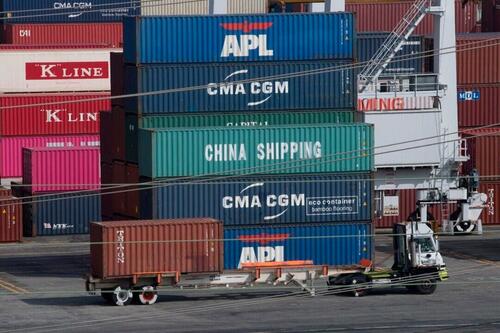Authored by James Gorrie via The Epoch Times,
Is a new boom in deceptive trading practices taking shape in many parts of the world? As the U.S.–China trade war intensifies, it certainly looks that way.
China’s Gray Trade Strategy Blunts Impact of US Tariffs
With U.S. tariffs reaching 145 percent on Chinese imports—at least at the time of this writing—Beijing’s new strategy seems to include the use of so-called gray trade to bypass American trade barriers. Gray trade involves rerouting goods through low-tariff countries, such as Vietnam, Mexico, or Malaysia, to conceal their Chinese origin and thereby reduce U.S. import duties.
This sneaky tactic has surged as a response to President Donald Trump’s aggressive tariff policies, making China’s goods less competitive in the U.S. market due to their added cost.
Gray Trade Loophole Strategy
The simple idea behind gray trade is to exploit loopholes in U.S. Rules of Origin, the trading guidance for determining a product’s country of origin for tariff purposes. Chinese goods, for example, will remain unassembled or may be about 90 percent manufactured before being shipped to an intermediary country. There, they undergo final production, assembly, processing, repackaging, or relabeling to qualify as originating from that country, rather than from China.
For example, Chinese electronic parts may be sent to Vietnam, assembled into a product, and then labeled, “Made in Vietnam.” This enables China to benefit from the 10 percent tariff on Vietnamese imports under Trump’s 2025 reciprocal tariff regime, instead of the 145 percent tariffs on Chinese goods.
It’s a perfectly sensible response by Beijing, and there’s no doubt that Chinese firms are rerouting goods through Vietnam, Mexico, and Turkey to exploit lower tariffs on goods sourced from those countries. A related tactic occurring in Mexico involves dividing goods into packages that are below the $800 tariff-free threshold for non-Chinese origins, a tactic called the “Tijuana two-step.”
China Has to Resort to Gray Trade
But gray trade isn’t new or even unfamiliar to the second Trump administration. During Trump’s first term, Chinese solar manufacturers bypassed 30 percent tariffs by partnering with their neighbors in Southeast Asia. In 2025, tracing the movement and provenance of vast numbers of products is complex at best and nearly impossible at worst, making it a challenge to disrupt gray trade.
It’s no mystery why Beijing is engaging in gray trade. With its exports to the United States accounting for 10 percent of its trade and supporting between 10 million and 20 million jobs, some experts say the world’s largest manufacturer faces an estimated 80 percent decline in its exports over the next two years, if the gray trade were to cease.
As domestic economic conditions decline due to the anticipated extensive trade tensions, China’s 2025 GDP projections have fallen from 5 percent to as low as 4 percent, potentially resulting in a 20 percent drop in GDP growth in just one year. With joblessness among its young people (ages 16 to 24) already approaching 17 percent, the Chinese Communist Party (CCP) faces a growing resentment among its people. The Party would like to avoid an uprising by its younger generation.
The gray trade has provided a much-needed cushion against the blow of the Trump administration’s high tariffs. For instance, according to official data, China’s exports surged by 12.4 percent in March, with exports to ASEAN increasing by 11.6 percent and exports to Vietnam climbing by nearly 19 percent.
Impact on Low-Tariff Countries
But it’s not just China that gains from gray trade. Its low-tariff country partners also gain economically from gray trade but face risks, too. Gray trading partners, such as Vietnam, Malaysia, and Mexico, profit from trade and processing fees, with some estimates on the social media platform X reaching as high as 10 percent. It’s worth noting that between 2017 and 2022, Vietnam replaced almost half of China’s lost market share in U.S. imports.
However, gray trading partner countries risk the consequences of U.S. pushback, resulting in a delicate balancing act for these countries caught between gray trade with China and managing important trading relationships with the United States.
Economic and Geopolitical Implications
Economically, gray trade preserves China’s U.S. market access for the moment, but it raises costs as intermediaries take their cut, with logistics costs also increasing. For U.S. consumers, it may delay steep price hikes, but won’t eliminate them.
Geopolitically, Beijing’s retaliatory 125 percent tariffs on U.S. goods, plus adding barriers to U.S. beef and LNG imports, raise tensions even higher. CCP leader Xi Jinping’s recent visits to Vietnam, Malaysia, and Cambodia could have secured their gray trade hubs going forward.
A Rough Road Ahead?
But the impact of gray trade is perhaps deeper and wider than many may expect. On the one hand, it’s a reasonable response on China’s part to U.S. tariffs. But on the other hand, there are greater risks. The United States could expand tariffs or use the International Emergency Economic Powers Act (IEEPA) to close loopholes.
That, too, may be a rational response by the United States, or it could make things worse.
“The global trade system for the past ninety years is collapsing, leaving it difficult for people to forecast the economic impact and tell where the bottom for a market is,” Vincent Chan, a China strategist at Aletheia Capital Ltd., told Bloomberg.
As new phases of U.S. trade policy and responses unfold, the biggest risk may be uncontrolled escalation in both tariff retaliation and other forms of retaliation. In short, the impact of the gray trade may be deeper and wider than many expect, and it could even lead to a global trade war, with its own far-reaching implications.
Views expressed in this article are opinions of the author and do not necessarily reflect the views of The Epoch Times or ZeroHedge.
Loading…


















